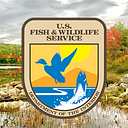Rhode Island River Revival
To celebrate National Rivers Month, we asked Tim Mooney, marketing and communications manager for The Nature Conservancy in Rhode Island to share some good news about rivers in The Ocean State. An avid hiker and birder, he managed two of the Conservancy’s flagship nature preserves from 2007–2016 and previously served in the Washington and Providence offices of U.S. Senators John Chafee and Lincoln Chafee. He lives in Cumberland, R.I. with his partner, Chris Audette.
Rhode Island’s environmental champion (and dear friend of the Fish and Wildlife Service), the late U.S. Senator John Chafee, was fond of saying, “Given half a chance, nature will rebound. But we must give nature that half a chance.”
For the past several years, The Nature Conservancy’s Rhode Island chapter has worked with the Service to give nature half a chance on the Pawcatuck River. Winding 34 miles through southern Rhode Island, the river abounds with wildlife, from osprey to otters and herons to herring. It’s hard to beat the meandering Pawcatuck River for summertime family paddling. Scientists describe it as the last and best semi-wilderness river system in the state.
Nevertheless, the lower reaches of the river were choked by the White Rock Dam. Two miles upriver from a municipal boat ramp in downtown Westerly, R.I., the dam, a legacy of the Industrial Revolution, blocked kayakers and migrating fish.
[caption id=”attachment_27006" align=”alignnone” width=”640"]
The White Rock Dam was on the Pawcatuck River, on the border of Connecticut and Rhode Island. Credit: The Nature Conservancy[/caption]
Although no longer serving a commercial purpose, the 6-foot-high concrete wall diverted the river into a long bypass canal. In spring, the river rushed through the canal with tremendous force, creating dangerous conditions for inexperienced kayakers. It also prevented all but a handful of river herring from migrating upstream to their traditional spawning grounds.
In 2015, the Conservancy and the Service, supported by federal funding for Hurricane Sandy recovery and resilience, came together to remove the dam and close the bypass canal. Two years later, the river is back on its natural course. Paddlers and fish are passing easily, and local flooding has been reduced. The lower Pawcatuck River has been set free for the first time in 250 years.
[caption id=”attachment_27007" align=”alignnone” width=”5248"]
The dam removal in 2016 was supported in part by federal funding for Hurricane Sandy recovery and resilience projects. Credit: The Nature Conservancy[/caption]
We want nature to thrive everywhere — not just “wild” places, but in our neighborhoods and historic waterfronts, too. For most of the 20th Century, the Crawford Street Bridge covered nearly ¼ mile of the Providence River in downtown Providence, R.I. Just upstream, the junction of the Woonasquatucket and Moshasseck rivers, which join to form the Providence, was hidden beneath the John O. Pastore Federal Building and Post Office.
The waterways below, which feed into Providence Harbor, were heavily polluted with industrial waste and sewage and, quite simply, stank. All of upper Narragansett Bay was horribly polluted. It was hard to imagine anyone sailing, fishing, or kayaking in those waters.
Today, thanks to an ambitious revitalization project in the 1980s, the Crawford Street Bridge is gone, replaced with a series of smaller spans, and the Woonasquatucket and Moshasseck meet in the open. Providence River is the cleanest it has been in seven generations, thanks to the vision, foresight, and hard work of many people and organizations. And public access to Providence’s natural resources is valued more than ever.
[caption id=”attachment_27008" align=”alignnone” width=”640"]
The Nature Conservancy oversaw the design and construction of the Gano Park boat ramp on the Providence waterfront. The project was supported in part by funds from the Wildlife and Sport Fish Restoration Program, administered by the Service. Credit: The Nature Conservancy[/caption]
In 2014, The Nature Conservancy partnered with the City of Providence and the R.I. Department of Environmental Management to open a new boat launch at Gano Park — the city’s first public ramp. Using funds from the Service’s Wildlife and Sport Fish Restoration Program, decades of illegal dumping were reversed, and the area was made safe again for people and wildlife.
The Conservancy helped design and manage the project, using innovative strategies to keep polluted storm-water run-off from entering the estuary. The ramp never would have been possible, however, without the support of the Service and countless hunters, archers, and anglers across the United States, who fund the WSFR program through taxes on sporting equipment, electric boat motors, and fuel.
A river remembers its natural, free-flowing course after 250 years. A boat ramp rises from a dumping ground as a neighborhood gateway to Narragansett Bay. Nature does rebound, just as Senator Chafee said. Across the state, Rhode Island’s waterways are bouncing back, and I hope you will celebrate nature’s resilience by exploring these special places this summer.

